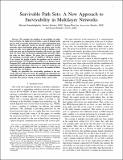| dc.contributor.author | Hyang-Won Lee, Marzieh | |
| dc.contributor.author | Parandehgheibi, Marzieh | |
| dc.contributor.author | Modiano, Eytan H | |
| dc.date.accessioned | 2017-09-15T18:30:38Z | |
| dc.date.available | 2017-09-15T18:30:38Z | |
| dc.date.issued | 2014-12 | |
| dc.date.submitted | 2014-10 | |
| dc.identifier.issn | 0733-8724 | |
| dc.identifier.issn | 1558-2213 | |
| dc.identifier.uri | http://hdl.handle.net/1721.1/111568 | |
| dc.description.abstract | One of the most important advances in modern communication networks is embedding multilayer network architectures such as IP-over-WDM.1 In these layered networks, a logical topology is embedded onto a physical topology such that each logical link is routed using a path in the physical topology. While such a layering approach makes it possible to take advantage of the flexibility of upper layer technology (e.g., IP) and the high data rates of lower layer technology (e.g., WDM), it raises a number of challenges for efficient and reliable operations. One challenge is providing protection for this layered network where loss of a single fiber may cause failure of multiple logical links using it. In this paper, we consider the protection problem in the two layered communication network, and extend it to the case of three layers consisting of a physical-logical communication network and a power grid.
The main objective in the protection of a communication network is to guarantee its connectivity in the case of a failure. Since in reality the probability of two simultaneous failures is very low, we assume that only one failure occurs at a time. The protection problem in single-layer networks is rather straightforward; namely, providing a pair of disjoint paths (one for primary and one for backup) guarantees a route between two nodes against any single link failure.
This approach, however, cannot be directly applied to layered networks, because a pair of seemingly disjoint paths at the logical layer may share a physical link and thus simultaneously fail in the event of a physical link failure. The notion of shared risk link group (SRLG) disjoint paths, i.e., two paths between the source and destination nodes that do not share any risk (e.g., fiber and conduit) was introduced in [1] and formulated in [2]. Nearly all the previous works in the context of layered network protection have focused on finding SRLG-disjoint paths ( [3]–[9] among others).
Although the SRLG-disjoint paths problem has been well studied, there are networks in which SRLG-disjoint paths do not exist between a source and a destination. There has been some efforts to address this challenge by choosing a pair of maximally disjoint SRLG paths; i.e., a pair of paths that share the minimum number of risks [2], [10], [11]. Clearly, this cannot survive any single failure; thus, we take an alternative approach that is based on finding a set of paths that together will survive any single failure. Thus, in the case that SRLG-disjoint paths do not exist, we may find three or more paths such that in the event of a failure, at least one of the paths remains connected. This notion of survivable path set generalizes the traditional notion of SRLG-disjoint paths, enables us to provide protection for a broader range of scenarios and increases the survivability of the network.
The concept of multiple survivable paths has been studied in the single-layer setting [12], [13], where they split data over multiple paths and ensure that the delay over all paths are limited. They select the paths so that in the case of failure of any path, all or a fraction of traffic is guaranteed to survive. However, this problem remains largely unexplored in the multilayer setting. We say that a pair of nodes (i,j) is survivable if in the case of any single physical failure, nodes i and j remain connected. Moreover, we say that a network is survivable if in the case of any single physical failure, the logical layer remains connected [14]. Clearly, this requires the survivability of every pair of nodes in the network; i.e., if there exists a pair of nodes that is not survivable, then the network is not survivable as well. Therefore, we define the general metric of “survivability” as the fraction of the total pairs of nodes that remain connected after a failure. A network is survivable if survivability is equal to one. | en_US |
| dc.language.iso | en_US | |
| dc.publisher | Institute of Electrical and Electronics Engineers (IEEE) | en_US |
| dc.relation.isversionof | http://dx.doi.org/10.1109/JLT.2014.2364843 | en_US |
| dc.rights | Creative Commons Attribution-Noncommercial-Share Alike | en_US |
| dc.rights.uri | http://creativecommons.org/licenses/by-nc-sa/4.0/ | en_US |
| dc.source | Prof. Modiano | en_US |
| dc.title | Survivable Path Sets: A New Approach to Survivability in Multilayer Networks | en_US |
| dc.type | Article | en_US |
| dc.identifier.citation | Parandehgheibi, Marzieh, et al. “Survivable Path Sets: A New Approach to Survivability in Multilayer Networks.” Journal of Lightwave Technology 32, 24 (December 2014): 4741–4752 © 2014 Institute of Electrical and Electronics Engineers (IEEE) | en_US |
| dc.contributor.department | Massachusetts Institute of Technology. Department of Aeronautics and Astronautics | en_US |
| dc.contributor.department | Massachusetts Institute of Technology. Laboratory for Information and Decision Systems | en_US |
| dc.contributor.mitauthor | Parandehgheibi, Marzieh | |
| dc.contributor.mitauthor | Modiano, Eytan H | |
| dc.relation.journal | Journal of Lightwave Technology | en_US |
| dc.eprint.version | Author's final manuscript | en_US |
| dc.type.uri | http://purl.org/eprint/type/JournalArticle | en_US |
| eprint.status | http://purl.org/eprint/status/PeerReviewed | en_US |
| dspace.orderedauthors | Parandehgheibi, Marzieh; Hyang-Won Lee, Marzieh; Modiano, Eytan | en_US |
| dspace.embargo.terms | N | en_US |
| dc.identifier.orcid | https://orcid.org/0000-0002-7102-6641 | |
| dc.identifier.orcid | https://orcid.org/0000-0001-8238-8130 | |
| mit.license | OPEN_ACCESS_POLICY | en_US |
| mit.metadata.status | Complete | |
